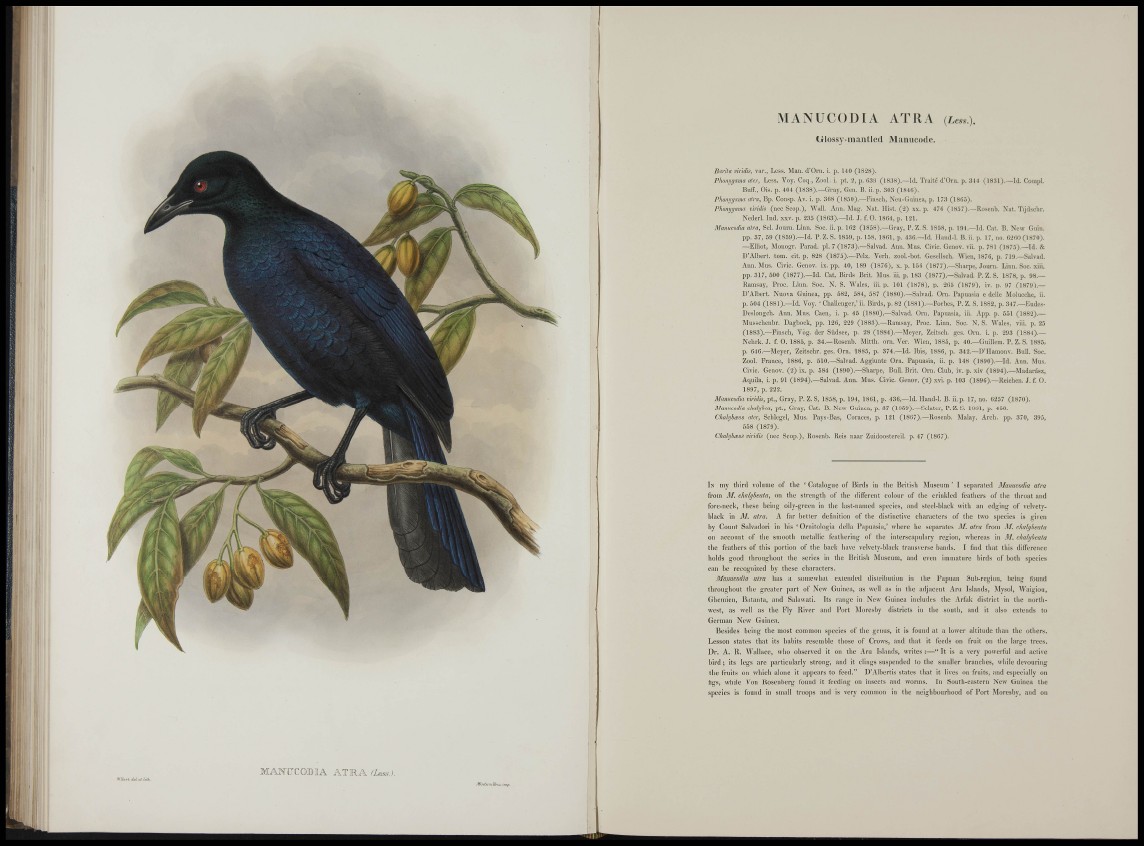
MANUCODIA ATRA {Less-.).
Glossy-iiKintled Manucoile.
Barila vlrtdis, var., Less. Man. d'Ora, i. p. 140 (1S28).
Plumi/gama ater, Less. Voy. Coq-, ZooL i. pt. 2, p. (i:iS (18:!8).—Td. Ti-aité d'Orn. p. DM (18:!1).—Id. Compi.
Buff., Ois. p. 401 (1838).—Gray, Geii. B. ii. p. 30.'i (184()).
Plwmjgama atra, Bp. Consp. Av. i. p. 3(i8 (1850).—Filiseli, Neii-Guinea, p. 173 (ISOfj).
Phmygmm viriiis (nec Scop.), Wall Ann. Mag. Nat. Hist. (-2) xk. p. 47(1 (18.57).—Rosenb. Nat. Tijdschr.
Nederl. Ind. xxv. p. 233 (1803).—Id. J. f. O. 18114, p. 121.
Manucodia atra, ScL .Tonrn. Linn. Soc. ii. p. 162 (1858).—Gray, P. Z. S. 1808, p. 194.—Id. Cat. B. New Guin.
pp. 37, 59 (1869).—Id. P. Z. S. 1859, p. 158, 1861, p. 430.—Id. Hand-I. B. il. p. 17, no. C2I10 (1870).
—Elliot, Monogr. Parad. pi. 7 (1873).—Salvad. Ann. Mus. Civic. Gcnov. vii. p. 781 (1875).—Id. &
D'Albert, torn. cit. p. 828 (1875).—Pelz. Verb, zool.-bot. Gesellsch. Wien, 1870, p. 719.—Salvad.
Ann. Mus. Civic. Genov. ix. pp. 40, 189 (1870), x. p. 156 (1877).—Sharpe, Journ. Linn. Soc. xiii.
pp. 317, 500 (1877).—Id. Cat. Birds Brit. Mus. iii. p. 183 (1877).—Salvad. P. Z. S. 1878, p. 98.—
Ramsay, Proc. Linn. Soc. N. S. Wales, iii. p. 101 (1878), p. 205 (1879), iv. p. 97 (1879).—
D'Albert. Nuova Guinea, pp. 082, 584, 587 (1880).—Salvad. Orn. Papuasia e delle Molueche, ii.
p. 604 (1881).—Id. Voy. ' Cballenger,' ii. Birds, p. 82 (1881).—Forbes, P. Z. S. 1882, p. 347.—Eudes-
Deslongch. Ann. Mus, Caen, i. p. 45 (1880).—Salvad. Orn. Papuasia, iii. App. p. 551 (1882).—
Musschenbr. Dagboek, pp. 126, 229 (1883).—Ramsay, Proc. Linn. Soc. N. S. Wales, viii. p. 25
(1883).—Finscli, Vog. der Siidsee, p. 28 (1884).—Meyer, Zeitsch. ges. Orn. i. p. 293 (1884).—
Nebrk. J. f. 0 . 1885, p. 34.—Rosenb. Mittb. orn. Ver. Wien, 1885, p. 40.—Guillera. P. Z. S. 1885,
p. 640.-Meyer, Zeitsclir. ges. Orn. 1885, p. 374.—Id. Ibis, 1886, p. 342.—D'llamonv. Bull. Soc.
Zool. France, 1880, p. 510.—Salvad. Aggiunte Orn. Papuasia, ii. p. 148 (1890).—Id. Ann. Mus.
Civic. Genov. (2) ix. p. 584 (1890).—Sbarpe, Bull. Brit. Orn. Club, iv. p. xiv (1894).—Madardsz,
Aquila, i. p. 91 (1894).—Salvad. Ann. Mus. Civic. Genov. (2) xvi. p. 103 (189G).—Reicbeu. J. f. 0.
1897, p. 222.
Maimcoiia viridis, pt.. Gray, P. Z. S. 1858, p. 194, 1861, p. 436.—Id. Hand-l. B. ii. p. 17, no. 6257 (1870).
Manucodia chalijhea, pt.. Gray, Cat. B. New Guinea, p. 37 (1869).—Sclater, P. Z.S. 1881, p. 450.
Chall/bteus ater, Schlegel, Mus. Pays-Bas, Coraces, p. 121 (1867).—Rosenb. Malay. Ardi. pp. 370, 395,
558 (1879).
Chali/baiis viridis (nec Scop.), Rosenb. Reis naar Zuidoostereil. p. 47 (1867).
IN my tliircl volume of tlie ' Catalogue of Birds in the Hritlsli Museum ' I separated Manucodia atra
from M, chahjhcata, on the strength of the dilferent colour of the crinkled feathers of the throat and
fore-neck, these being oily-green in tiie last-named sjjecics, and steel-black witli an edging of velvet)'-
black in M. atra, A far better definition of the distinctive characters of the two species is given
by Count Salvador! in his ' Ornitologia delia Papuasia,' where he separates M. atra from M. chalybeata
on account of the smooth metallic feathering of the interscaindary region, whereas in M. chahjhcata
the feathers of this ])ortion of the back have velvety-hlack transverse bands. I find that this diff'erence
holds good throughout the series in the British Museum, and even immature birds of both species
can be recognized by these characters.
Manucodia atra has a somewhat extended distribution in the Papuan Sub-region, being found
throughout the greater part of New Guinea, as well as in the adjacent Am Islands, Mysol, Waigioii,
Ghemien, Bataiita, and Salawati. Its range in New Guinea includes the Arfak district in the northwest,
as well as the Fly River and Port Moresby districts in the south, and it also extends to
German New Guinea.
Besides being the most common species of the gemjs, it is found at a lower altitude than the others.
Lesson states that its habits resemble those of Crows, and that it feeds on fruit on the large trees.
Dr. A. R. Wallace, who observed it on the Am Islands, writes : — I t is a very powerful and active
bird ; its legs are particularly strong, and it clings suspended to the smaller branches, while devouring
the fruits on which alone it appears to feed." D'Albertis states that it lives on fruits, and especially on
figs, while Von Rosenberg found it feeding on insects and worms. In South-eastern New Guinea the
species is found in small troops and is very common in the neighbourhood of Port Moresby, and on
dA rt liffi
A ATRA /less.).
!!